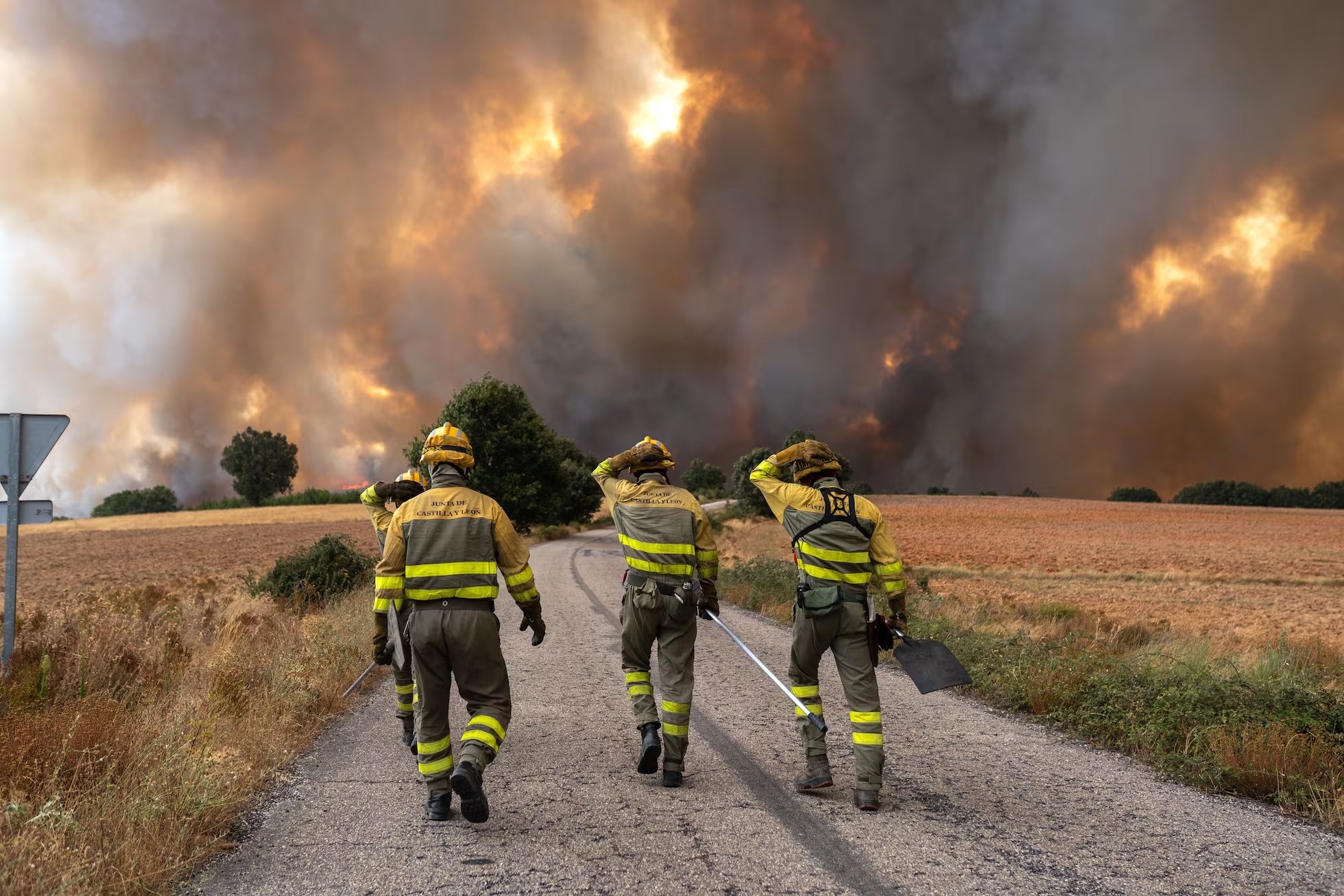Climate-heating emissions from wildfires in the European Union have surged to record levels this year as flames have engulfed over 1 million hectares of land – equal to 13 times the size of New York City – since January.
Blazes sweeping through the continent – with major hotspots in Spain and Portugal – have so far released 38.37 million tonnes of carbon dioxide (CO2) emissions into the atmosphere, more than the annual CO2 emissions of Sweden, according to data from the European Forest Fire Information System (EFFIS).
That’s more than double the average historical CO2 emissions recorded during the same months over the last 20 years.
The Iberian countries have suffered their worst fire season on record, with blazes killing at least seven people, displacing thousands more and destroying homes and crops in August, as the peninsula sweltered through heatwaves.
Mark Parrington, a senior scientist at the EU’s Copernicus Atmosphere Monitoring Service (CAMS), told Climate Home that the fires ravaging Spain and Portugal this month have caused “extreme emissions”.
In Spain alone, fire-related emissions this year are now four times higher than the average annual total, Parrington added.
‘Feedback loop’ between climate change and fires
Forests act as important carbon sinks, but when they burn, they release back into the atmosphere the carbon stored in the trunks, branches and leaves of their trees as well as in the soil.
“In fighting climate change, every effort counts – and of course, increasing emissions from forest fires is not good news,” said Paolo Laj, head of the Global Atmosphere Watch team at the World Meteorological Organization (WMO).
Scientists have warned of the emergence of a ‘feedback loop’ between climate change and fires. Rising greenhouse gas (GHG) emissions produce hotter and drier conditions that make it easier for fires to develop and spread. Worsening fires release vast quantities of stored carbon into the atmosphere, further accelerating global warming.


Globally, forest fires account for a relatively small share of emissions when compared with the use of fossil fuels and other human activities.
But their impact has been growing rapidly in recent years. In both 2023 and 2024, fires surged across the world – from tropical rainforests in South America to boreal forests in Canada and Russia – releasing more greenhouse gases than the annual emissions of India, according to analysis from the World Resources Institute (WRI).
WMO’s Laj said the share of global CO2 emissions caused by fires will likely continue to increase with the growing frequency and intensity of fires.
Risk for national emissions targets
Surging blazes also risk threatening forests’ role in helping countries to meet their climate targets.
Many countries are relying on land carbon sequestration – including through forests – to hit their 2030 and 2035 emissions-reduction goals, instead of taking more action elsewhere, for example by cutting the use of planet-heating fossil fuels.
The Australian government, for example, has faced criticism for repeatedly revising upwards projections of how much carbon its land sector could remove from the atmosphere while expanding its oil and gas production.
Similarly, COP30 host nation Brazil has been accused of obfuscating the role of forest sinks through opaque accounting used in its latest nationally determined contribution (NDC).
The EU has yet to publish a new climate plan with an emissions-reduction target for 2035. But, when Brussels last updated its NDC in 2023, it raised its reliance on land carbon sinks to meet its 2030 goal.
Bill Hare, CEO of think-tank Climate Analytics, said governments need to adopt a more realistic view of how much the land sector, including forests, can contribute to their climate targets as rising fires threaten their carbon sequestration potential.
“Will the EU get the sink that they planned for? I doubt it,” he told Climate Home News, adding that Brussels might require more action from other sectors to compensate for the weakening of its forests.
Accounting for wildfire emissions
Currently, countries generally exclude emissions from wildfires in their national greenhouse gas inventories submitted to the UN climate body.
That’s because they focus on human-made emissions and, under guidelines from the Intergovernmental Panel on Climate Change, wildfires are regarded as natural disturbances unless they result in permanent land use changes, such as turning forest into farmland.
But Hare said countries should start accounting for forest fires in a more systemic way when setting climate targets.
“Twenty-five years ago, you could say wildfires were random and forests would regrow. Unfortunately, what we see now is that fires are becoming more frequent, along with drought and heat, and forests are not recovering,” he said. “This is not an act of God.”

